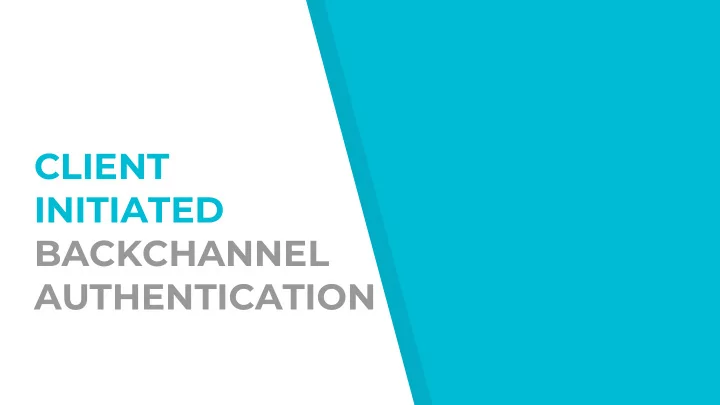

CLIENT INITIATED BACKCHANNEL AUTHENTICATION
CIBA? CIBA is an authentication flow like OpenID Connect. However, unlike OpenID Connect, there is direct Relying Party to OpenID Provider communication without redirects through the user's browser. This specification has the concept of a Consumption Device (on which the user interacts with the Relying Party) and an Authentication Device (on which the user authenticates with the OpenID Provider and grants consent). This specification allows a Relying Party that has an identifier for a user to obtain tokens from the OpenID Provider. The user starts the flow with the Relying Party at the Consumption Device, but authenticates and grants consent on the Authentication Device.
BRIEF HISTORY
WHY DECOUPLED For when the AUTHENTICATION device is not the CONSUMPTION device. 1. Granting authorisation to remote call centre agent 2. Using the strongly authenticated session on a smart device to grant authorisation to another device that is input constrained, or doesn’t belong to the user.
WHY CIBA Many decoupled flows are possible using existing redirect based flows. CIBA should not be used as a shortcut CIBA provides no way to cryptographically bind the session on the authentication device to the session on the consumption device. BUT - CIBA is better than some of the ways decoupled is already implemented.
DECOUPLED IN THE WILD
DECOUPLED IN THE WILD
CIBA FOR PAYMENTS “
THE CIBA FLOW Back-channel 1. RP to OP: user123 wants to grant access to me Front-channel 2. OP to user123: do you grant access to RP? 3. user123 to OP: yep Back-channel 4. OP to RP: here is a token that allows you access for user123
CIBA MODES POLL RP polls the token endpoint PING OP sends a notification to the RP RP gets tokens from token endpoint PUSH OP pushes tokens to the RP
AUTHENTICATION REQUEST POST /bc-auth HTTP/1.1 Host: server.example.com Authorization: Basic czZCaGRSa3F0MzpnWDFmQmF0M2JW Content-Type: application/x-www-form-urlencoded scope =openid%20email%20example-scope& client_notification_token =8d67dc78-7faa-4d41-aabd-67707b374255& binding_message=W4SCT& login_hint_token =eyJ … ..Ahawe7IPQ AUTHENTICATION RESPONSE HTTP/1.1 200 OK Content-Type: application/json Cache-Control: no-store { "auth_req_id": "1c266114-a1be-4252-8ad1-04986c5b9ac1", "expires_in": 3600, "interval": 2 }
PING CALLBACK POST /cb HTTP/1.1 Host: client.example.com Authorization: Bearer 8d67dc78-7faa-4d41-aabd-67707b374255 Content-Type: application/json { "auth_req_id": "1c266114-a1be-4252-8ad1-04986c5b9ac1" } TOKEN REQUEST POST /token HTTP/1.1 Host: server.example.com Content-Type: application/x-www-form-urlencoded Authorization: Basic czZCaGRSa3F0MzpnWDFmQmF0M2JW grant_type=urn%3Aopenid%3Aparams%3Agrant-type%3Aciba & auth_req_id=1c266114-a1be-4252-8ad1-04986c5b9ac1
TWO PROBLEMS Session Binding How do you ensure that the user at the authentication device is granting access to the correct consumption device? Identification What user identifier does the relying party use and how does it obtain it?
IDENTIFICATION Four options Discovery - this works well with MNOs ▸ Static Identifier - open to abuse ▸ Dynamic single-use identifier - generated by the ▸ OP, this also solves the binding problem Previously issued ID Token - which could have been ▸ received via a redirect flow All options supported by CIBA ( login_hint_token, id_token_hint & login_hint )
SESSION BINDING Three options Use a dynamic single-use identifier ▸ Let the user decide - If there is enough context on ▸ the authorisation being sought Binding message - displayed on the consumption ▸ device, verified by the user on the authentication device
ID TOKEN HINT OAuth is rarely one-time use. Using an ID Token as a hint for CIBA provides a nice balance between usability and privacy. 1. Get an ID Token via a redirect flow 2. The ID Token binds the user’s account at the OP with the user’s account at the RP 3. When the user identifies herself at the RP, the RP can use the previously issued ID Token to start a CIBA flow
THANKS! @davidgtonge Moneyhub
Recommend
More recommend